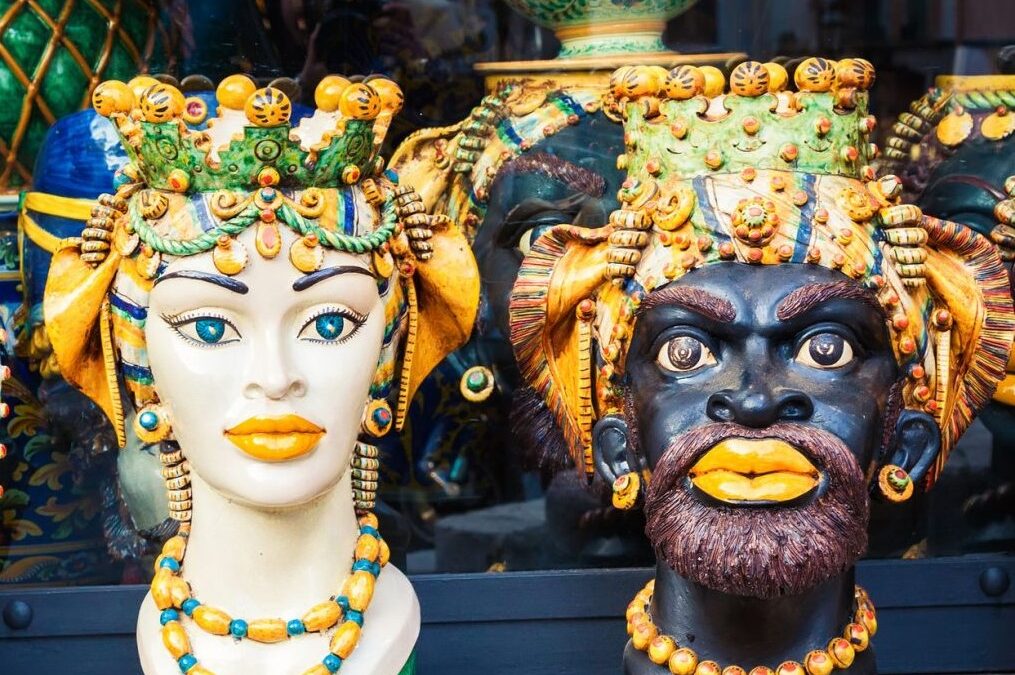Sicilian Moor’s Heads: Legends, Literary Allusions, and Artistic Craftsmanship
Visitors to Sicily will undoubtedly notice a pair of ceramic heads – a black male head and a white female head – in restaurants, hotels or shops. Much like Ethan in The White Lotus, they won’t be able to help but ask, “Hey, what is with these head things? We keep seeing them everywhere”.
Sicily’s traditional decorative vases, known as Moor’s Heads or ‘teste di moro’, are a testament to the island’s cultural richness and craftsmanship. Made from hand-painted ceramic, these vases depict the faces of a man and a woman, adorned with intricate detail, and serve as symbolic representations of Sicilian culture. Rooted in a legend that dates back to the Moorish domination of Sicily in 1100, these vases tell tales of tragic love that have endured through the centuries.
Legends of love and betrayal:
The legend behind the Moorish heads unfolds in a tale of love and betrayal. When a beautiful girl discovers her Moorish lover’s deception, she takes matters into her own hands and ends his life in his sleep. In a twist of fate, she uses his decapitated head as a container to plant basil, symbolising the flourishing of life even in the face of heartbreak. This poignant story has given rise to the tradition of Moor’s heads as decorative vases, often displayed in pairs, encapsulating the young couple’s tragic love story.
In another version of the story, a Sicilian girl falls in love with a young Arab. When her family finds out about their affair, they behead them both and their heads are turned into vases and displayed on a balcony as a warning.
Moor’s heads in the literary tradition: Boccaccio and Keats
The intriguing story of the Moor’s heads has gone beyond folklore and found its way into the works of literary masters such as Giovanni Boccaccio and John Keats.
In Boccaccio’s “Decameron”, the tragic love story of a noblewoman, Lisabetta, and her lover, Lorenzo, unfolds in Messina. Her disapproving brothers plan to eliminate Lorenzo by taking him out of town and murdering him. After Lorenzo mysteriously disappears, Lisabetta has a dream in which he reveals the location of his burial. She digs up Lorenzo’s body, reburies it elsewhere and preserves his head. Lisabetta and her maid place it in a clay pot filled with earth and basil. The basil flourishes, nourished by Lisabetta’s tears and the decomposing head. When her brothers discover the affair, they confiscate the pot and bury Lorenzo’s head without saying a word. Heartbroken, Lisabetta cries herself to death.
Similarly, in “Isabella; or the Pot of Basil”, John Keats tells the story of Isabella, a young woman whose family plans to marry her off to “a high nobleman and his olive trees”. Instead, she falls in love with Lorenzo, an employee of her brothers. Upon discovering their love, the brothers commit a heinous act, murdering Lorenzo and hiding his body. Lorenzo’s ghost visits Isabella in a dream and reveals the tragic truth. Driven by grief, she exhumes his body and buries his head in a pot of basil, which she tends with obsessive devotion, all the while languishing in grief. These literary allusions contribute to the enduring cultural significance of the Moor’s Heads.
The Moor’s Heads in “The White Lotus”:
In a contemporary context, Moor’s Heads make a notable appearance in the second series of The White Lotus. The show weaves the legend into a disturbing exchange between characters, using the vases as a warning against infidelity. As guests navigate the intricacies of relationships, the Moor’s heads serve as a subtle reminder of the enduring themes of love, betrayal and consequences.
Artistic Craftsmanship: From clay to creation:
The process of making Moor’s Heads, or “Teste di Moro”, is a meticulous and skilled craft performed entirely by hand. Steps include shaping the clay, refining and detailing the ceramic heads, the crucial first firing, glazing in the distinctive Sicilian maiolica style, a second firing for a glossy finish and final touches to complete the unique pieces. This artisanal process reflects Sicily’s rich tradition of ceramic artistry, introduced to the island by the Arabs.
More than just decorative vases, Sicilian Moor’s Heads are vessels of history, legend and artistic prowess. From ancient tales of tragic love to modern interpretations in popular culture, Moor’s Heads continue to symbolise the enduring power of love, even in the face of adversity. As visitors explore Sicily, these intricately crafted vases serve as a tangible reminder of the island’s cultural depth and the resilience of its stories.

